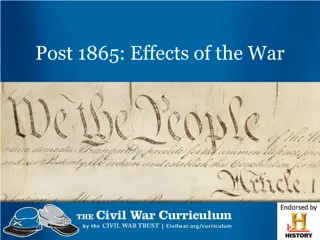Reconstruction Period after the Civil War: Plans and Challenges
The Reconstruction period after the Civil War in the United States saw various plans proposed by President Abraham Lincoln, Republicans in Congress, President Andrew Johnson, and Radical Republicans. These plans aimed to rebuild the country and bring the Southern states back into the Union, addressing issues such as loyalty oaths, abolition of slavery, voting rights, and state governments. However, differing approaches led to challenges in implementing a unified reconstruction process.
Download Presentation

Please find below an Image/Link to download the presentation.
The content on the website is provided AS IS for your information and personal use only. It may not be sold, licensed, or shared on other websites without obtaining consent from the author. Download presentation by click this link. If you encounter any issues during the download, it is possible that the publisher has removed the file from their server.
E N D
Presentation Transcript
Post 1865: Effects of the War American Battlefield Trust
Reconstruction What will be done when the war is over? Reconstruction - The period following the Civil War in which Congress passed laws designed to rebuild the country and bring the Southern states back into the Union.
President Abraham Lincoln Lincoln wanted the country to come back together peacefully. Lincoln s plan was created in 1863, about two years before the end of the war. At the time of his death, the war was just ending and he was not able to put his ideas into practice. The Ten Percent Plan 10% of voters in the seceded states must swear loyalty under oath to the Union. The seceded states must abolish slavery.
Republicans in Congress Wanted to be more strict with the States that had rebelled. Wanted a State to re-enter through a slower admission process. Wade-Davis Bill The majority of white men from formerly Confederate states must swear loyalty to the United States. The seceded states must abolish slavery. Former Confederate soldiers or volunteers cannot hold office or vote.
President Andrew Johnson Wanted to be strict with the States that had rebelled, but ended up making it relatively easy for them. Allowed for segregation of the races. Johnson Plan The majority of white men from formerly Confederate states must swear loyalty to the United States. Formerly Confederate states must ratify the 13th Amendment. Former Confederate officials may hold office and vote.
Radical Republicans Radical republicans, often abolitionists, represented a large part of Congress. These Congressmen wanted to be strict with the States that had rebelled. Reconstruction Act Formerly Confederate states must disband their state governments. Formerly Confederate states must write new state constitutions. Formerly Confederate states must ratify the 14th Amendment Formerly Confederate states must allow African Americans to vote.

















































